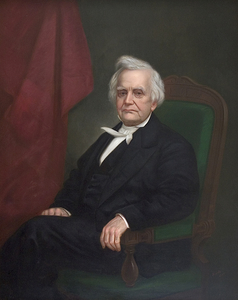
Pitman, John (1785-1864)
Role:Dates:
Portrait Location: Library Annex
Artist: Arnold, John Nelson (1834-1907)
Portrait Date: 1867
Medium: Oil on canvas
Dimensions:
Framed Dimensions:
Brown Portrait Number: 28
Brown Historical Property Number: 1283
John Pitman was the successful son of a onetime rope maker's apprentice. From humble beginnings, his father became one of the most prominent preachers in Rhode Island. His father, also named John Pitman (1751-1822), was left bereft at the age of thirteen, when his father died. The young boy was apprenticed to a rope maker and by all accounts lived a profligate life until his conversion at the age of twenty. This elder John Pitman eventually became a Baptist preacher, and after years of rather nomadic employment, relocated his family to Providence in 1765. His son, John, was born in February of that year. When preaching proved too ill-paying to support a family, the elder John Pitman briefly took a post at Brown University as the Steward of the College. It was natural that his son, as the child of a prominent community leader, would continue his family's association with Brown. The younger John Pitman received his Bachelor of Arts from Brown in 1799, and like so many of his contemporaries, chose to study law. His early career as an attorney was marked by relocations that mimic his father's early years as an itinerate pastor: he began his practice in New York City in 1806. 1807 found him in Kentucky, and in 1808, he relocated to his hometown of Providence, Rhode Island, for four years. He later took his practice to Salem, Massachusetts, and to Portsmouth, New Hampshire, prior to his 1820 return to Providence. This latter move was professionally fortuitous, as the next year, he became a U.S. District Attorney for the District of Rhode Island. Pitman had the professional acumen and social capital to attract the attention of President James Monroe, who in 1824 appointed him to fill a vacant federal judgeship on the U.S. District Court, District of Rhode Island. Pitman was approved by the U.S. Senate in 1825 and served in this capacity until his death thirty-nine years later.
Pitman's marriage of fifty-one years is at least as impressive in duration as his long term on the federal bench. In 1812, during one of his legal sojourns in Rhode Island, he married Mary Talbot. Pitman's future wife came, like him, from a family that rose from humbler origins to achieve prominence socially and intellectually in the growing town of Providence. Though her father was illiterate, he owned a dry-goods business and real estate that enabled him to send his daughter to the Balch Academy, a school where upper class girls were taught a lady's share of academics and art. By the time of her marriage to John Pitman, Mary Talbot had been trained as a suitable wife for a man of rising influence. The couple had nine children, several of which achieved prominence in the Grand Army of the Republic during the Civil War. Mary Pitman died in 1863, and her husband followed the next year.
This portrait was painted by John Nelson Arnold (1834-1909), a native of Providence, who spent much of his artistic career painting people of influence within the state. It is signed by him and dated 1867. This painting was funded by contributions which were originally given to Brown University to start a military school on the campus; with the permission of donors, the portrait was painted instead of establishing the school.
